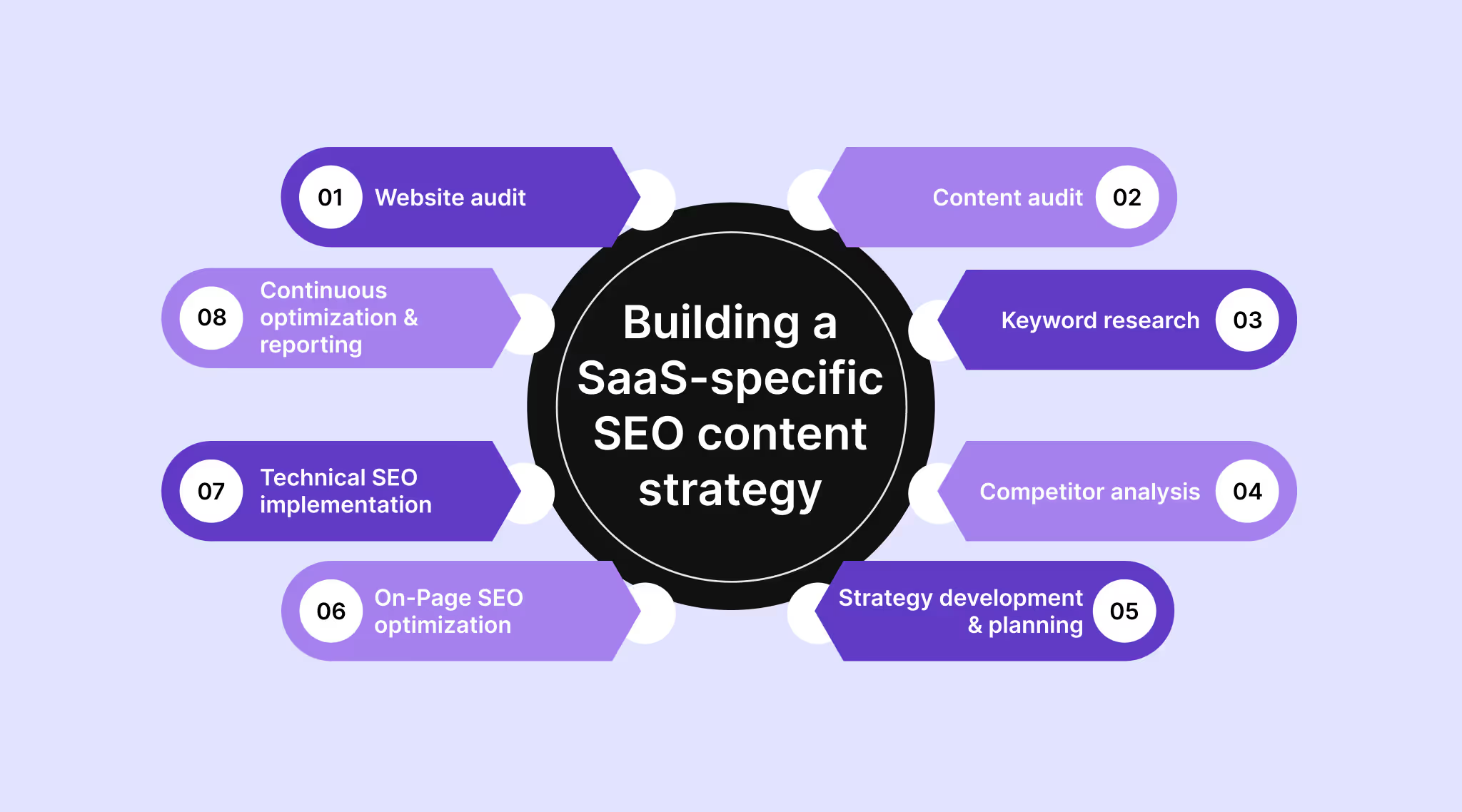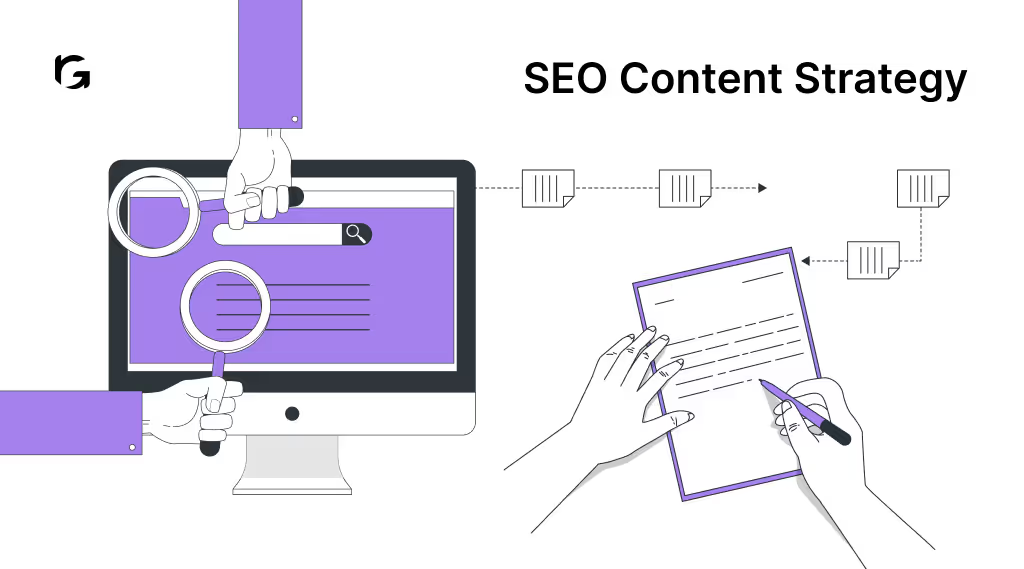Introduction
Ever noticed how organic traffic seems to be the lifeblood of successful websites? Here's a stat to put things in perspective: According to Ironpaper, organic search drives 300% more traffic to websites than social media. Yes, you read that right! If you're a VP of Content or a Content Manager, you're probably nodding along, realizing how crucial SEO is for driving those clicks. But it’s not just about getting traffic—it’s about getting the right traffic. And that's where a well-thought-out SEO content strategy comes into play.
Why SaaS Teams Need an SEO Content Strategy?
Let’s face it—just pumping out content won’t cut it anymore. The internet is flooded with articles, blogs, videos, and infographics, all vying for attention. Without a solid SEO content strategy, you're basically throwing spaghetti at the wall and hoping something sticks. So, why do you need an SEO content strategy?
- Targeted traffic
- Improved visibility
- Long-term results
1. Targeted traffic
An SEO strategy helps you attract visitors who are genuinely interested in what you offer. Relevant keywords and optimized content ensure the right audience finds your site, leading to better engagement and higher conversion rates. This approach reduces bounce rates and makes your marketing efforts more effective.
2. Improved visibility
Boosting your chances of appearing on Google’s first page means you're in front of 75% of users who don’t scroll past. High rankings build trust and make potential customers more inclined to choose your business over competitors. Increased visibility also translates to more organic traffic for your site.
3. Long-term results
Unlike paid ads, which disappear when you stop paying, SEO continues to bring in traffic long after the initial work is done. With improved site authority and quality content, rankings can remain strong and continue to attract visitors. Investing in SEO delivers ongoing value and reduces the need for constant ad spending.
8 Steps in building a SaaS-specific SEO content strategy
So, how do you go about building an SEO content strategy that's tailored for SaaS? Here are seven steps to get you started:

- Website audit
- Content audit
- Keyword research
- Competitor analysis
- Strategy development & planning
- On-page SEO optimization
- Technical SEO implementation
- Continuous optimization & reporting
1. Website audit
Start with a thorough evaluation of your website. Assess traffic patterns, user behavior, site architecture, and navigation using tools like Google Analytics and Search Console. Identify any issues such as broken links, duplicate content, and slow page speeds to establish a strong foundation.
2. Content audit
Evaluate the effectiveness of your existing content. Use tools like Screaming Frog to identify top-performing pieces and uncover content gaps. This will help you understand what needs to be updated, repurposed, or created from scratch to better serve your audience.
3. Keyword research
Conduct initial keyword discovery using tools like Ahrefs and SEMrush. Group keywords into relevant categories, then refine the list to target high-value terms that align with your business goals and audience needs. Ahrefs says that 96.55% of content gets no organic traffic from Google, often because it doesn’t target the right keywords. So, focus on keywords with substantial search volume and relevance.
4. Competitor analysis
Identify and study your key competitors using tools like SEMrush and SimilarWeb. Analyze their SEO strategies, content, and backlink profiles to gain insights that can be leveraged to refine your own strategy and outperform them in search rankings.
5. Strategy development & planning
Create a comprehensive SEO plan based on your audits and research. Define clear goals and KPIs, and develop a roadmap that includes content strategy, link-building activities, and technical SEO improvements. This step ensures a cohesive and targeted approach.
6. On-Page SEO optimization
Optimize your content by refining meta titles, descriptions, and headers. Improve internal linking, incorporate multimedia elements, and ensure that your content is both user-friendly and search engine-friendly. This enhances your content’s visibility and engagement.
7. Technical SEO implementation
Focus on the technical aspects of your website to improve its performance. Optimize page load speeds, implement mobile-friendly designs, and ensure your site is secure with HTTPS. In fact, Google has made page experience a key ranking factor in 2024, so don’t overlook this aspect. Also, make sure search engines can easily crawl and index your site by submitting XML sitemaps and fixing any crawl errors.
8. Continuous optimization & reporting
SEO is not a one-time task. Continuously monitor your website's performance with tools like Google Analytics and SEMrush. Conduct regular content audits, adjust keyword strategies, and refine your on-page and off-page tactics. Provide monthly reports to stakeholders, keeping them informed of your progress and results.
Common pitfalls in SaaS SEO content strategy (and how to avoid them)
Even with the best intentions, it's easy to fall into some common traps when building your SaaS SEO content strategy. Here are a few to watch out for:
- Overstuffing keywords: It might be tempting to cram your content with keywords, but this can backfire. Google’s algorithms are smart enough to spot this and could penalize your site.
- Ignoring User Experience (UX): A website that’s hard to navigate will frustrate users and increase bounce rates, which hurts your SEO. SEMrush states that websites with high bounce rates (over 70%) typically rank lower in search results.
- Neglecting analytics: Not monitoring your performance means you’re flying blind. Use analytics to track what’s working and what isn’t, and tweak your strategy accordingly.
- Skipping technical SEO: Technical issues like slow load times or broken links can kill your SEO efforts. Regularly audit your site to catch these problems early.
https://revvgrowth.com/saas-content-marketing/mistakes/
The role of content refreshing in long-term SEO success
SEO isn’t a one-and-done deal; it’s an ongoing process. Content refreshing plays a crucial role in maintaining and even boosting your SEO rankings over time. Here’s why:
1. Keeps content relevant
Google favors up-to-date content. Refreshing old posts with new information, updated statistics, or additional insights can keep them relevant.
2. Improves search rankings
Updating content can signal to Google that it’s still valuable, potentially improving your rankings.
3. Enhances user experience
Visitors are more likely to trust and engage with content that feels current and relevant, which can lead to lower bounce rates and higher conversions.
How Revv Growth can help you develop a high-impact SaaS SEO content strategy
To see how an effective SEO strategy works in practice, look at Atlan’s success story. Atlan, a platform for data teams, faced challenges with low organic search visibility despite offering a valuable service:
- Atlan’s situation: The company struggled with poor search rankings and suboptimal content. Their product was strong, but their online presence didn’t reflect that.
- Our approach: We crafted a detailed SEO strategy for Atlan. This involved:
- Targeted Keyword Research: Identifying key terms to attract their ideal audience.
- Content overhaul: Enhancing their existing content to meet SEO standards and audience needs.
- Optimization for SERPs: Aiming for top rankings and optimizing for featured snippets.
- The result: Atlan experienced a 500% increase in organic traffic. This remarkable growth not only improved their visibility but also solidified their market position.
This success is reflective of broader trends: A 2024 Ahrefs report highlights that businesses investing in SEO often see an average return of 5.7 times their initial investment, demonstrating SEO’s cost-effectiveness and value for SaaS companies.
Bottom line?
Relying on outdated methods won't cut it in today's digital arena. A fresh, strategic SEO approach is essential for standing out and capturing your audience's attention. By focusing on current best practices and refining your strategy with regular updates, you can significantly enhance your visibility and traffic. Ready to make a change? Find the top 5 saas content marketing agencies today who can help you get started.



.svg)


.webp)